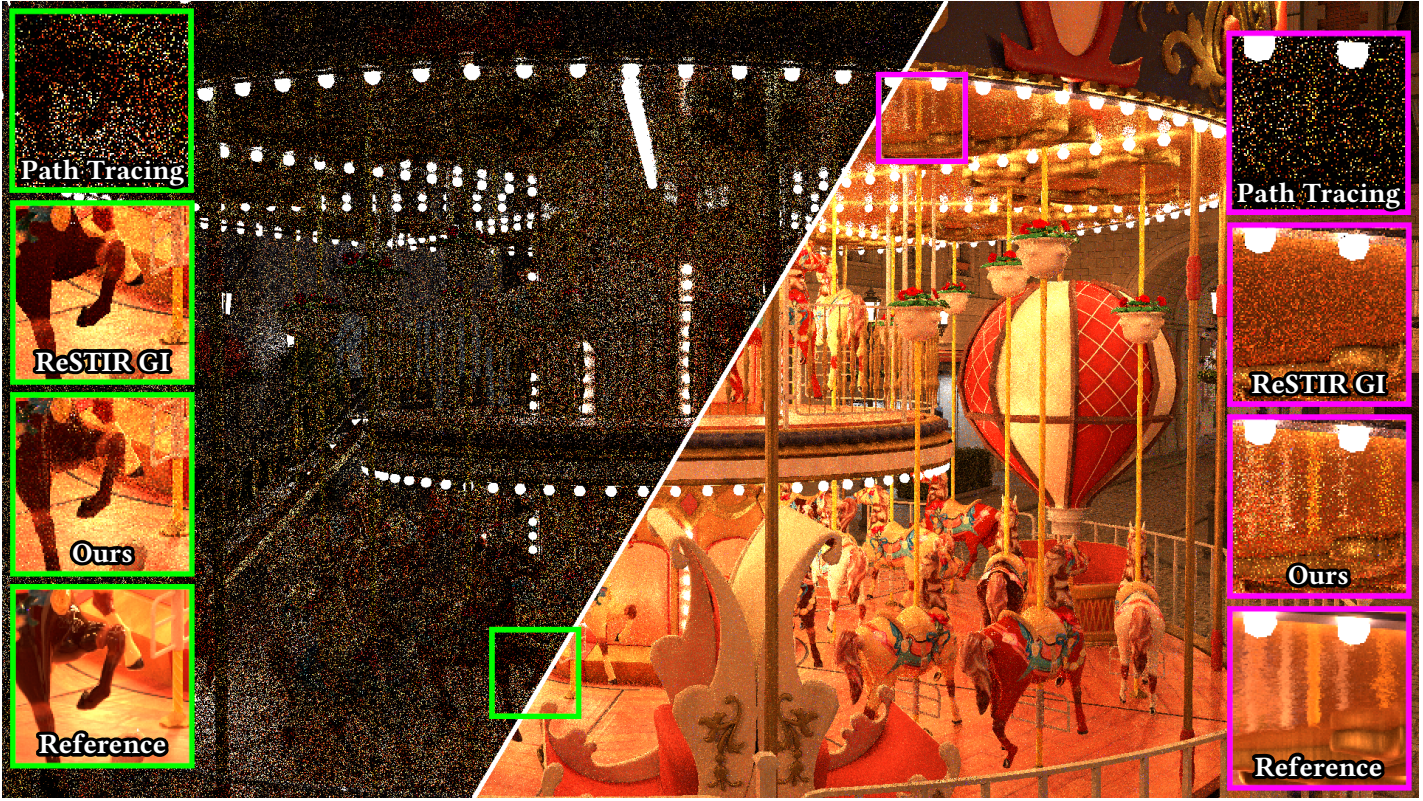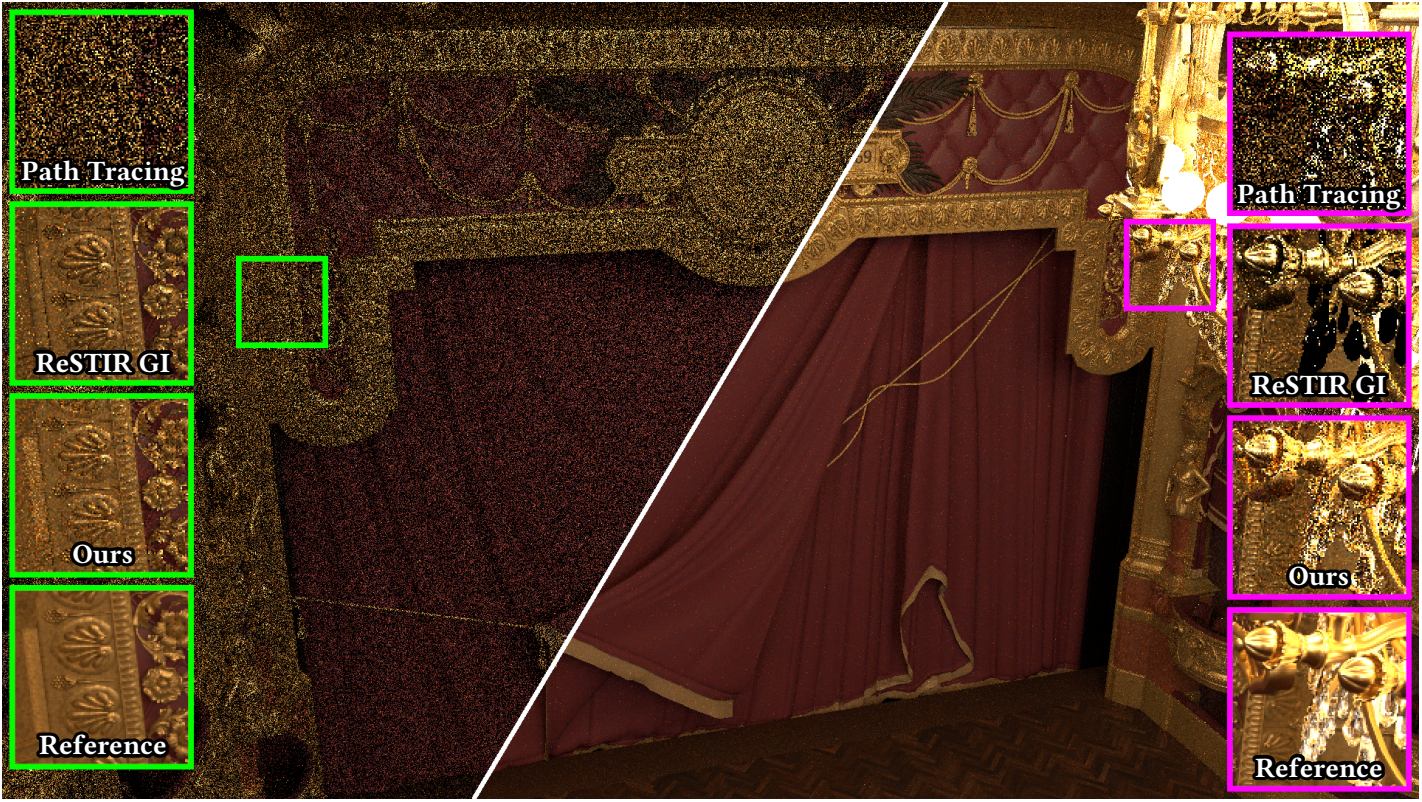[Supplemental Document]
[Paper Video] [Source Code]
[Interative Comparisons]
[SIGGRAPH Talk (YouTube)]
["Two Minute Papers" (YouTube)]
Abstract
As scenes become ever more complex and real-time applications embrace ray tracing, path sampling algorithms that maximize quality at low sample counts become vital. Recent resampling algorithms building on Talbot et al.’s [2005] resampled importance sampling (RIS) reuse paths spatiotemporally to render surprisingly complex light transport with a few samples per pixel.
These reservoir-based spatiotemporal importance resamplers (ReSTIR) and their underlying RIS theory make various assumptions, including sample independence. But sample reuse introduces correlation, so ReSTIR-style iterative reuse loses most convergence guarantees that RIS theoretically provides.
We introduce generalized resampled importance sampling (GRIS) to extend the theory, allowing RIS on correlated samples, with unknown PDFs and taken from varied domains. This solidifies the theoretical foundation, allowing us to derive variance bounds and convergence conditions in ReSTIR-based samplers. It also guides practical algorithm design and enables advanced path reuse between pixels via complex shift mappings.
We show a path-traced resampler (ReSTIR PT) running interactively on complex scenes, capturing many-bounce diffuse and specular lighting while shading just one path per pixel. With our new theoretical foundation, we can also modify the algorithm to guarantee convergence for offline renderers.
Equal time path tracing (left) vs. ReSTIR PT (right, ours)

 Our new generalized resampled importance sampling (GRIS) theory extends resampled importance sampling [Talbot 2005] to guarantee
convergence even when applied to correlated samples arising from spatiotemporal reuse (i.e., Bitterli et al. [2020]). GRIS allows applying ReSTIR to
reuse arbitrary paths, shown with paths of length 10 in the Carousel (up) and Paris Opera House (bottom). Main images compare naive path tracing and our
new ReSTIR PT in equal time (80 ms at 1920 × 1080). Insets show equal-time path tracing, ReSTIR GI [Ouyang et al. 2021], our ReSTIR PT, plus a
converged reference. We significantly improve quality for glossy interreflection, reflections, refractions, and other high-frequency lighting. For
Carousel, MAPE errors: path tracing (1.63), ReSTIR GI (0.45), and ReSTIR PT (0.39). Corresponding errors in Opera House: 1.28, 0.39, and 0.33.
(Carousel ©carousel_world; Paris Opera House courtesy ©GoldSmooth from TurboSquid.)
Our new generalized resampled importance sampling (GRIS) theory extends resampled importance sampling [Talbot 2005] to guarantee
convergence even when applied to correlated samples arising from spatiotemporal reuse (i.e., Bitterli et al. [2020]). GRIS allows applying ReSTIR to
reuse arbitrary paths, shown with paths of length 10 in the Carousel (up) and Paris Opera House (bottom). Main images compare naive path tracing and our
new ReSTIR PT in equal time (80 ms at 1920 × 1080). Insets show equal-time path tracing, ReSTIR GI [Ouyang et al. 2021], our ReSTIR PT, plus a
converged reference. We significantly improve quality for glossy interreflection, reflections, refractions, and other high-frequency lighting. For
Carousel, MAPE errors: path tracing (1.63), ReSTIR GI (0.45), and ReSTIR PT (0.39). Corresponding errors in Opera House: 1.28, 0.39, and 0.33.
(Carousel ©carousel_world; Paris Opera House courtesy ©GoldSmooth from TurboSquid.)
Video
BibTeX
@article{Lin*2022,
author = {Daqi Lin* and Markus Kettunen* and Benedikt Bitterli and Jacopo Pantaleoni and Cem Yuksel and Chris Wyman},
title = {Generalized Resampled Importance Sampling: Foundations of ReSTIR},
journal = {ACM Transactions on Graphics (Proceedings of SIGGRAPH 2022)},
year = {2022},
month = {07},
volume = {41},
number = {4},
pages = {75:1--75:23},
articleno = {75},
numpages = {23},
location = {Vancouver, Canada},
url = {https://doi.org/10.1145/3528223.3530158},
doi = {10.1145/3528223.3530158},
issn = {0730-0301},
publisher = {ACM Press},
address = {New York, NY, USA},
note = {(*Joint First Authors)},
}